duminică, 28 noiembrie 2010
marți, 23 noiembrie 2010
Secrete cu care vei face faţă bolilor din sezonul rece
1. Consumă legume la fiecare masă
Infecţiile respiratorii care se înmulţesc la venirea iernii pot fi prevenite printr-o alimentaţie echilibrată, bogată în fructe şi legume proaspete. Nelipsite de pe masa ta ar trebui să fie merele, portocalele şi lămâile, care împreună cu roşiile, gogoşarii, ceapa, usturoiul şi ardeiul iute trebuie consumate zilnic, pentru întărirea sistemului imunitar.
2. Apără-ţi copilul de infecţii periculoase
Boala pneumococică este cea mai frecventă infecţie la copii, iar simptomele sale sunt foarte asemănătoare cu cele ale virozelor, incluzând şi febra. Ca să previi îmbolnăvirea puiului tău, vaccinează-l din timp cu un ser contra acestei afecţiuni. Dacă în alte ţări această injecţie este gratuită, la noi serul trebuie cumpărat din farmacii.
3. Imunizează-te cu seruri naturale
Poate nu ştiai, dar există vaccinuri homeopate care au efect dovedit în faţa afecţiunilor de sezon, precum virozele şi gripa. Aceste seruri sunt recomandate mai ales persoanelor care nu tolerează injecţiile clasice, fiind alergice la componentele acestora. Înainte de a opta pentru produsele naturale, consultă-ţi medicul de familie.
4. Ceaiurile de plante îţi dau energie
Nici o zi fără ceaiuri care să te hidrateze, să te încălzează şi să te învioreze! După fiecare ceaşcă savurată, vei vedea că vei fi plin(ă) de energie şi poftă de viaţă. Încearcă infuziile din fructe de pădure sau cele de ceai verde cu lămâie, iar dacă apreciezi mai mult plantele medicinale, apelează la brânduşa de toamnă, levănţică sau mentă.
5. Ia suplimente alimentare
Suplimentele sunt foarte practice şi îţi oferă exact ce alimentaţia ta zilnică nu poate acoperi. Alege comprimate care îţi asigură necesarul zilnic de vitamine esenţiale şi de minerale. Dacă vrei doar să îţi întăreşti imunitatea, cere farmacistului vitamina C şi urmează cu stricteţe indicaţiile de administrare.
6. Fă-ţi anual vaccinul antigripal
Vaccinarea se face toamna, înainte de venirea frigului, pentru a lăsa timp organismului să îşi creeze populaţia de anticorpi responsabilă cu protecţia antigripală. Bolnavii cronici, vârstnicii şi copiii se pot imuniza gratuit la medicul de familie, în timp ce alte persoane trebuie să cumpere serul din farmacii.
7. Mergi la un control medical de rutină
Dacă suferi de o afecţiune cronică, sfârşitul toamnei e momentul când trebuie să îi faci o vizită medicului tău. El îţi poate recomanda să repeţi anumite analize şi îţi poate schimba tratamentul, pentru ca organismul tău să facă faţă schimbărilor de temperatură şi de umiditate specifice venirii iernii.
8 .Gustările din timpul nopţii îţi distrug dinţii
Un studiu făcut de cercetătorii de la Universitatea din Copenhaga arată că persoanele care mănâncă noaptea riscă să-şi distrugă dinţii. Studiul a fost realizat pe 2.200 de femei şi bărbaţi, dintre care 8% aveau prostul obicei de a se trezi în timpul nopţii pentru o gustare. Monitorizarea a arătat că după şase ani, cei care mâncau noaptea au avut mai multe probleme cu dantura şi au ajuns chiar să-şi piardă dinţii, spre deosebire de cei care nu şi-au întrerupt somnul pentru a face excursii la frigider.
9. Detoxifiere cu păpădie
Prescrisă ca tratament natural pentru hepatita C şi pentru anemie, păpădia mai are o mulţime de beneficii pentru sănătate. De exemplu, pentru că ajută la eliminarea toxinelor şi a sării în exces, e indicată în detoxificarea ficatului şi buna funcţionare a sistemului digestiv. Acţionează ca diuretic, dar, totodată, tratează şi diareea, pentru că are proprietăţi antibacteriene.
10. Lactatele te ajută să ai un păr frumos
Proteinele din lactate sunt foarte importante pentru creşterea părului. Benefice pentru podoaba capilară sunt şi vitamina C, care e esenţială pentru structura firului de păr, cerealele integrale, bogate în fibre, carnea, pentru că are proteine, fier şi zinc, şi apa, care favorizează transportul nutrienţilor în organism şi întăreşte firul de păr.
11. Vinetele scad colesterolul
Sărace în calorii (doar 27 la 100 de grame) şi bogate în vitamine, vinetele blochează formarea radicalilor liberi şi reduc nivelul de colesterol rău din sânge. Sunt o sursă excelentă de acid folic, calciu, magneziu, zinc, fosfor, fier şi potasiu, vitamina C şi vitamina B9. Au efect laxativ, ca urmare a fibrelor pe care le conţin, şi stimulează activitatea ficatului şi a pancreasului.
12. Prunele sunt antidepresive
Renumite ca laxativ natural, prunele au şi un puternic efect tonic asupra celulelor nervoase, ca urmare a concentraţiei crescute de vitamine din gama B. Sunt recomandate în perioadele de convalescenţă şi pentru combaterea depresiei. Prunele mai au capacitatea de proteja împotriva cataractei, într-o măsură mult mai mare decât o pot face alte fructe şi legume. În plus, nu sunt o ameninţare pentru siluetă, fiindcă au puţine calorii: o prună = 35 de calorii.
13. Scapă de răul de maşină cu ghimbir
Răul de maşină - ameţeala şi starea de greaţă indusă de viteza vehiculului, de schimbarea direcţiei sau de virajele bruşte - trece cu ghimbir. Acesta poate fi consumat sub formă de capsule sau de infuzie şi trebuie administrat înainte de plecare. Răul de maşină e frecvent întâlnit la femei şi la copiii cu vârste cuprinse între 5 şi 12 ani.
14. Cafeaua previne bolile de inimă
Ca şi ceaiul, cafeaua ne protejează de bolile de inimă, susţin cercetătorii din Olanda. În urma unui studiu realizat pe o perioadă de 13 ani, timp în care au fost monitorizate 40.000 de persoane, specialiştii au ajuns la concluzia că şase ceşcuţe de cafea sau de ceai consumate zilnic micşorează riscul de afecţiuni cardiace cu o treime. Dacă beţi mai mult de şase ceşcuţe, rolul protector al cafelei sau al ceaiului nu creşte, ci, în mod paradoxal, se anulează.
15. Sportul, indicat în anxietate
Cercetătorii americani de la Universitatea Georgia susţin că persoanele care au boli cronice pot scăpa de anxietatea provocată de afecţiunea de care suferă cu ajutorul exerciţiilor fizice. Ei au descoperit că mişcarea este mai eficientă decât medicamentele prescrise pentru anxietate şi, spre deosebire de acestea, nu are efecte secundare.
Dieta grupei sangvine
“Înainte de începerea unui regim, oamenii ar trebui să-şi facă analizele, pentru a se evita carenţele de vitamine şi de minerale”, a spus medicul.
Miracles You’ll See In The Next Fifty Years: An Article from 1950
Like most predictions about the future, this article from Popular Mechanics dated Feb, 1950, does a pretty mediocre job. Some predictions are accurate, some are wrong, and many of them are plain weird or impractical. It’s a long article, but it sure makes an entertaining read.
A text version of the entire article can be found after these images.

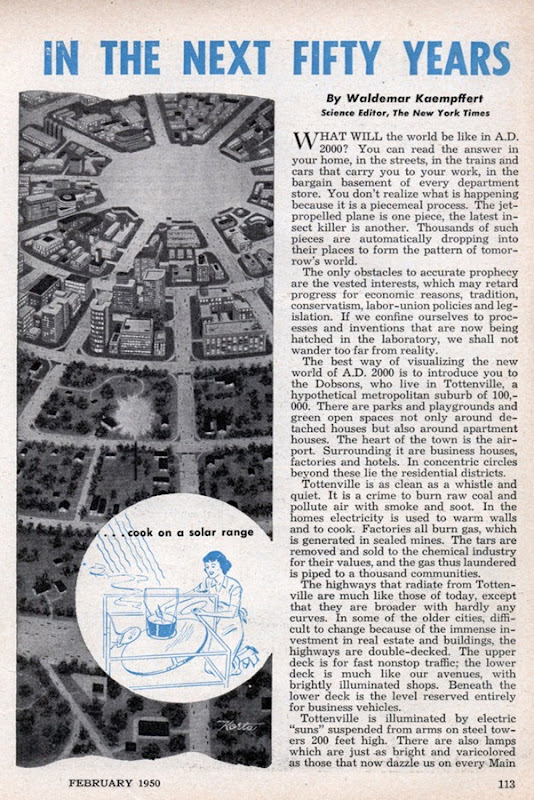
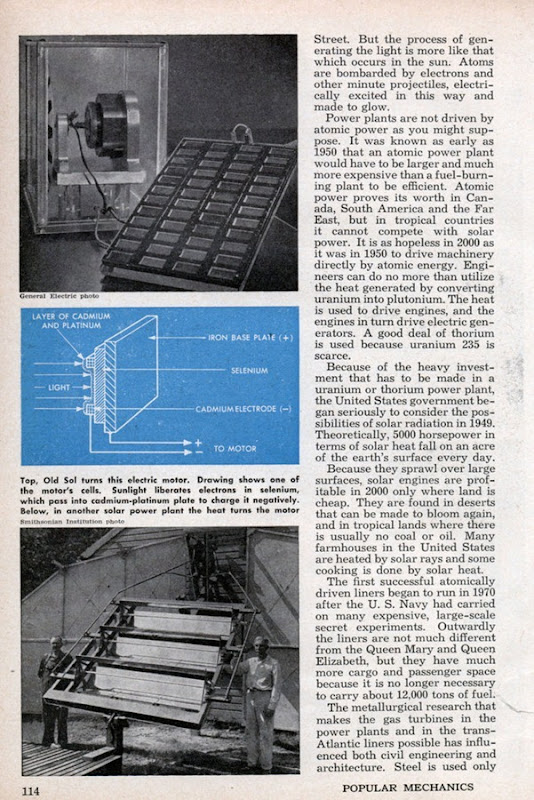

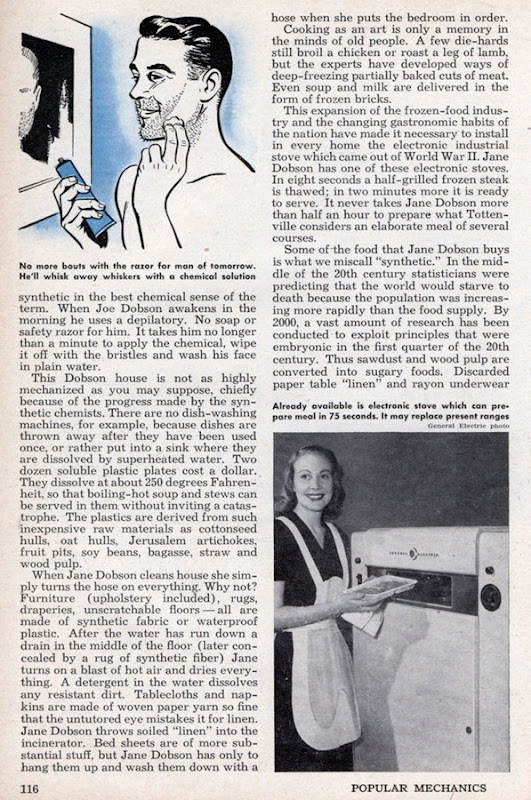
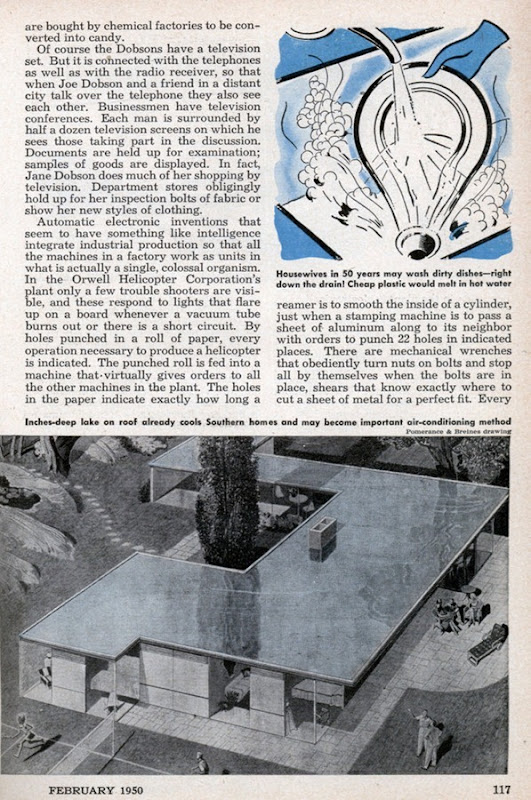

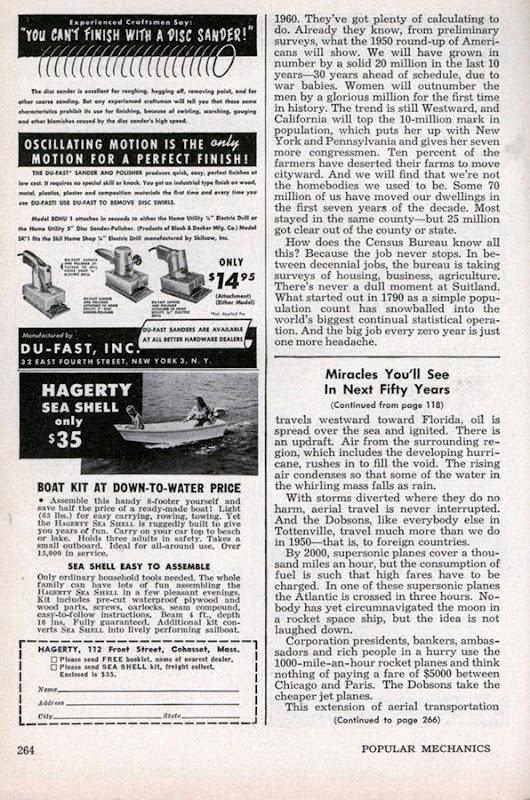
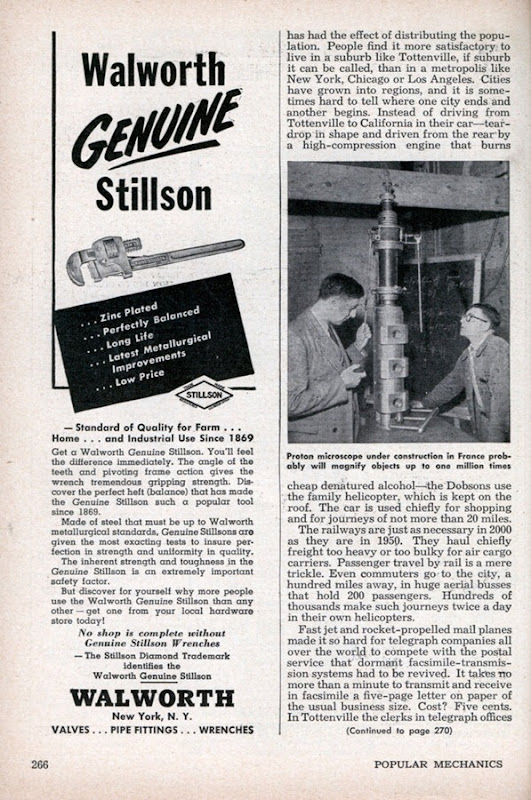
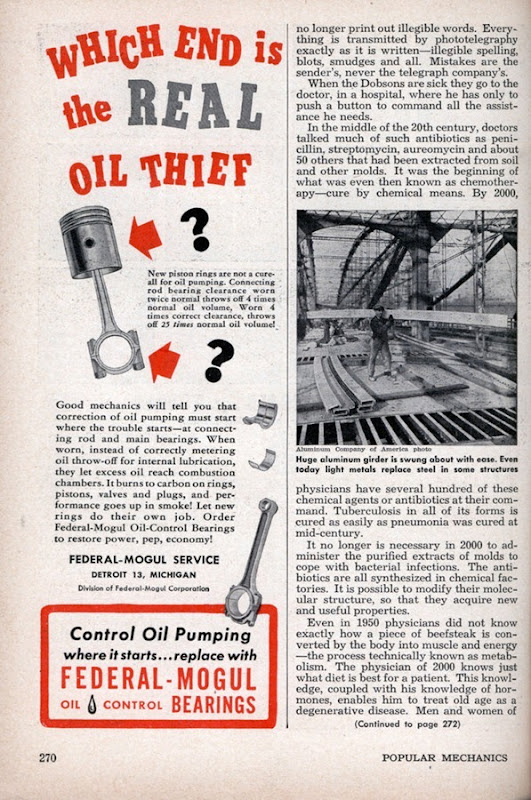
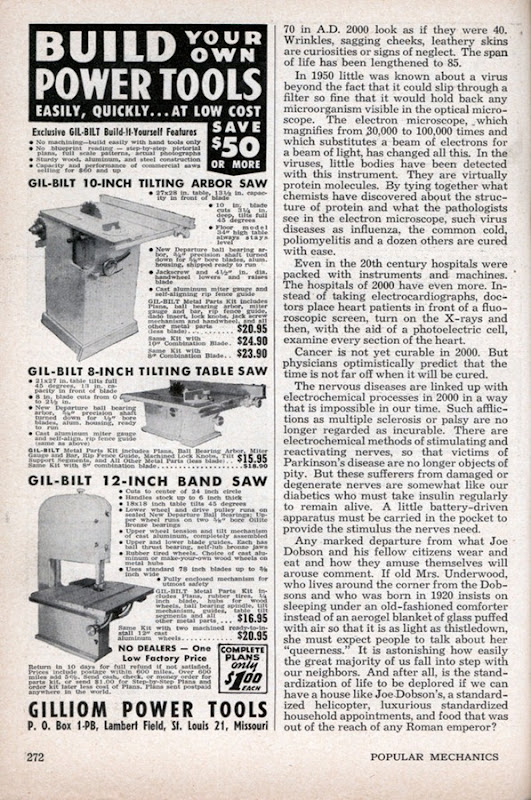
Miracles You’ll See In The Next Fifty Years
By Waldemar KaempffertScience Editor, The New York Times
WHAT WILL the world be like in A.D. 2000? You can read the answer in your home, in the streets, in the trains and cars that carry you to your work, in the bargain basement of every department store. You don’t realize what is happening because it is a piecemeal process. The jet-propelled plane is one piece, the latest insect killer is another. Thousands of such pieces are automatically dropping into their places to form the pattern of tomorrow’s world.
The only obstacles to accurate prophecy are the vested interests, which may retard progress for economic reasons, tradition, conservatism, labor-union policies and legislation. If we confine ourselves to processes and inventions that are now being hatched in the laboratory, we shall not wander too far from reality.
The best way of visualizing the new world of A.D. 2000 is to introduce you to the Dobsons, who live in Tottenville, a hypothetical metropolitan suburb of 100,000. There are parks and playgrounds and green open spaces not only around detached houses but also around apartment houses. The heart of the town is the airport. Surrounding it are business houses, factories and hotels. In concentric circles beyond these lie the residential districts.
Tottenville is as clean as a whistle and quiet. It is a crime to burn raw coal and pollute air with smoke and soot. In the homes electricity is used to warm walls and to cook. Factories all burn gas, which is generated in sealed mines. The tars are removed and sold to the chemical industry for their values, and the gas thus laundered is piped to a thousand communities.
The highways that radiate from Tottenville are much like those of today, except that they are broader with hardly any curves. In some of the older cities, difficult to change because of the immense investment in real estate and buildings, the highways are double-decked. The upper deck is for fast nonstop traffic; the lower deck is much like our avenues, with brightly illuminated shops. Beneath the lower deck is the level reserved entirely for business vehicles.
Tottenville is illuminated by electric “suns” suspended from arms on steel towers 200 feet high. There are also lamps which are just as bright and varicolored as those that now dazzle us on every Main Street. But the process of generating the light is more like that which occurs in the sun. Atoms are bombarded by electrons and other minute projectiles, electrically excited in this way and made to glow.
Power plants are not driven by atomic power as you might suppose. It was known as early as 1950 that an atomic power plant would have to be larger and much more expensive than a fuel-burning plant to be efficient. Atomic power proves its worth in Canada, South America and the Far East, but in tropical countries it cannot compete with solar power. It is as hopeless in 2000 as it was in 1950 to drive machinery directly by atomic energy. Engineers can do no more than utilize the heat generated by converting uranium into plutonium. The heat is used to drive engines, and the engines in turn drive electric generators. A good deal of thorium is used because uranium 235 is scarce.
Because of the heavy investment that has to be made in a uranium or thorium power plant, the United States government began seriously to consider the possibilities of solar radiation in 1949. Theoretically, 5000 horsepower in terms of solar heat fall on an acre of the earth’s surface every day.
Because they sprawl over large surfaces, solar engines are profitable in 2000 only where land is cheap. They are found in deserts that can be made to bloom again, and in tropical lands where there is usually no coal or oil. Many farmhouses in the United States are heated by solar rays and some cooking is done by solar heat.
The first successful atomically driven liners began to run in 1970 after the U. S. Navy had carried on many expensive, large-scale secret experiments. Outwardly the liners are not much different from the Queen Mary and Queen Elizabeth, but they have much more cargo and passenger space because it is no longer necessary to carry about 12,000 tons of fuel.
The metallurgical research that makes the gas turbines in the power plants and in the trans-Atlantic liners possible has influenced both civil engineering and architecture. Steel is used only for cutting tools and for massive machinery. The light metals have largely displaced it. Ways have been found to change the granular structure so that a metal is ultrastrong in a desired direction and weaker in other directions. As a result, the framework of an industrial or office building or apartment house is an almost lacelike lattice.
Thanks to these alloys, to plastics and to other artificial materials, houses differ from those of our own time. The Dobson house has light-metal walls only four inches thick. There is a sheet of insulating material an inch or two thick with a casing of sheet metal on both sides.
This Dobson air-conditioned house is not a prefabricated structure, though all its parts are mass-produced. Metal, sheets of plastic and aerated clay (clay filled with bubbles so that it resembles petrified sponge) are cut to size on the spot. In the center of this eight-room house is a unit that contains all the utilities - air-conditioning apparatus, plumbing, bathrooms, showers, electric range, electric outlets. Around this central unit the house has been pieced together. Some of it is poured plastic - the floors, for instance. By 2000, wood, brick and stone are ruled out because they are too expensive.
It is a cheap house. With all its furnishings, Joe Dobson paid only $5000 for it. Though it is galeproof and weatherproof, it is built to last only about 25 years. Nobody in 2000 sees any sense in building a house that will last a century.
Everything about the Dobson house is synthetic in the best chemical sense of the term. When Joe Dobson awakens in the morning he uses a depilatory. No soap or safety razor for him. It takes him no longer than a minute to apply the chemical, wipe it off with the bristles and wash his face in plain water.
This Dobson house is not as highly mechanized as you may suppose, chiefly because of the progress made by the synthetic chemists. There are no dish washing machines, for example, because dishes are thrown away after they have been used once, or rather put into a sink where they are dissolved by superheated water. Two dozen soluble plastic plates cost a dollar. They dissolve at about 250 degrees Fahrenheit, so that boiling-hot soup and stews can be served in them without inviting a catastrophe. The plastics are derived from such inexpensive raw materials as cottonseed hulls, oat hulls, Jerusalem artichokes, fruit pits, soy beans, bagasse, straw and wood pulp.
When Jane Dobson cleans house she simply turns the hose on everything. Why not? Furniture (upholstery included), rugs, draperies, unscratchable floors are all are made of synthetic fabric or waterproof plastic. After the water has run down a drain in the middle of the floor (later concealed by a rug of synthetic fiber) Jane turns on a blast of hot air and dries everything. A detergent in the water dissolves any resistant dirt. Tablecloths and napkins are made of woven paper yarn so fine that the untutored eye mistakes it for linen. Jane Dobson throws soiled “linen” into the incinerator. Bed sheets are of more substantial stuff, but Jane Dobson has only to hang them up and wash them down with a hose when she puts the bedroom in order.
Cooking as an art is only a memory in the minds of old people. A few die-hards still broil a chicken or roast a leg of lamb, but the experts have developed ways of deep-freezing partially baked cuts of meat. Even soup and milk are delivered in the form of frozen bricks.
This expansion of the frozen-food industry and the changing gastronomic habits of the nation have made it necessary to install in every home the electronic industrial stove which came out of World War II. Jane Dobson has one of these electronic stoves. In eight seconds a half-grilled frozen steak is thawed; in two minutes more it is ready to serve. It never takes Jane Dobson more than half an hour to prepare what Tottenville considers an elaborate meal of several courses.
Some of the food that Jane Dobson buys is what we miscall “synthetic.” In the middle of the 20th century statisticians were predicting that the world would starve to death because the population was increasing more rapidly than the food supply. By 2000, a vast amount of research has been conducted to exploit principles that were embryonic in the first quarter of the 20th century. Thus sawdust and wood pulp are converted into sugary foods. Discarded paper table “linen” and rayon underwear are bought by chemical factories to be converted into candy.
Of course the Dobsons have a television set. But it is connected with the telephones as well as with the radio receiver, so that when Joe Dobson and a friend in a distant city talk over the telephone they also see each other. Businessmen have television conferences. Each man is surrounded by half a dozen television screens on which he sees those taking part in the discussion. Documents are held up for examination; samples of goods are displayed. In fact, Jane Dobson does much of her shopping by television. Department stores obligingly hold up for her inspection bolts of fabric or show her new styles of clothing.
Automatic electronic inventions that seem to have something like intelligence integrate industrial production so that all the machines in a factory work as units in what is actually a single, colossal organism. In the Orwell Helicopter Corporation’s plant only a few trouble shooters are visible, and these respond to lights that flare up on a board whenever a vacuum tube burns out or there is a short circuit. By holes punched in a roll of paper, every operation necessary to produce a helicopter is indicated. The punched roll is fed into a machine that virtually gives orders to all the other machines in the plant. The holes in the paper indicate exactly how long a reamer is to smooth the inside of a cylinder, just when a stamping machine is to pass a sheet of aluminum along to its neighbor with orders to punch 22 holes in indicated places. There are mechanical wrenches that obediently turn nuts on bolts and stop all by themselves when the bolts are in place, shears that know exactly where to cut a sheet of metal for a perfect fit. Every operation in the plant is electronically and automatically controlled.
One of the more remarkable electronic machines of 2000 is a development of one on which hundreds of thousands of dollars had been spent in the middle years of the 20th century by Dr. Vladimir Zworykin and Dr. John von Neumann. The purpose of this improved Zworykin-Von Neumann automaton is to predict the weather with an accuracy unattainable before 1980. It is a combination of calculating machine and forecaster. The calculator solves thousands of separate equations in a minute; the automatic forecaster carries out the computer’s instructions and predicts the weather from hour to hour. In 1950, meteorologists had no time to deal with the 50-odd variables that should have been mathematically handled to predict the weather 24 hours in advance.
Following suggestions made by Zworykin and Von Neumann storms are more or less under control. It is easy enough to spot a budding hurricane in the doldrums off the coast of Africa. Before it has a chance to gather much strength and speed as it travels westward toward Florida, oil is spread over the sea and ignited. There is an updraft. Air from the surrounding region, which includes the developing hurricane, rushes in to fill the void. The rising air condenses so that some of the water in the whirling mass falls as rain.
With storms diverted where they do no harm, aerial travel is never interrupted. And the Dobsons, like everybody else in Tottenville, travel much more than we do in 1950—that is, to foreign countries.
By 2000, supersonic planes cover a thousand miles an hour, but the consumption of fuel is such that high fares have to be charged. In one of these supersonic planes the Atlantic is crossed in three hours. Nobody has yet circumnavigated the moon in a rocket space ship, but the idea is not laughed down.
Corporation presidents, bankers, ambassadors and rich people in a hurry use the 1000-mile-an-hour rocket planes and think nothing of paying a fare of $5000 between Chicago and Paris. The Dobsons take the cheaper jet planes.
This extension of aerial transportation has had the effect of distributing the population. People find it more satisfactory to live in a suburb like Tottenville, if suburb it can be called, than in a metropolis like New York, Chicago or Los Angeles. Cities have grown into regions, and it is sometimes hard to tell where one city ends and another begins. Instead of driving from Tottenville to California in their car - teardrop in shape and driven from the rear by a high-compression engine that burns cheap denatured alcohol - the Dobsons use the family helicopter, which is kept on the roof. The car is used chiefly for shopping and for journeys of not more than 20 miles. The railways are just as necessary in 2000 as they are in 1950. They haul chiefly freight too heavy or too bulky for air cargo carriers. Passenger travel by rail is a mere trickle. Even commuters go to the city, a hundred miles away, in huge aerial busses that hold 200 passengers. Hundreds of thousands make such journeys twice a day in their own helicopters.
Fast jet and rocket-propelled mail planes made it so hard for telegraph companies all over the world to compete with the postal service that dormant facsimile-transmission systems had to be revived. It takes no more than a minute to transmit and receive in facsimile a five-page letter on paper of the usual business size. Cost? Five cents. In Tottenville the clerks in telegraph offices no longer print out illegible words. Everything is transmitted by phototelegraphy exactly as it is written - illegible spelling, blots, smudges and all. Mistakes are the sender’s, never the telegraph company’s.
When the Dobsons are sick they go to the doctor, in a hospital, where he has only to push a button to command all the assistance he needs.
In the middle of the 20th century, doctors talked much of such antibiotics as penicillin, streptomycin, aureomycin and about 50 others that had been extracted from soil and other molds. It was the beginning of what was even then known as chemotherapy - cure by chemical means. By 2000, physicians have several hundred of these chemical agents or antibiotics at their command. Tuberculosis in all of its forms is cured as easily as pneumonia was cured at mid-century.
It no longer is necessary in 2000 to administer the purified extracts of molds to cope with bacterial infections. The antibiotics are all synthesized in chemical factories. It is possible to modify their molecular structure, so that they acquire new and useful properties.
Even in 1950 physicians did not know exactly how a piece of beefsteak is converted by the body into muscle and energy - the process technically known as metabolism. The physician of 2000 knows just what diet is best for a patient. This knowledge, coupled with his knowledge of hormones, enables him to treat old age as a degenerative disease. Men and women of 70 in A.D. 2000 look as if they were 40. Wrinkles, sagging cheeks, leathery skins are curiosities or signs of neglect. The span of life has been lengthened to 85.
In 1950 little was known about a virus beyond the fact that it could slip through a filter so fine that it would hold back any microorganism visible in the optical microscope. The electron microscope, which magnifies from 30,000 to 100,000 times and which substitutes a beam of electrons for a beam of light, has changed all this. In the viruses, little bodies have been detected with this instrument. They are virtually protein molecules. By tying together what chemists have discovered about the structure of protein and what the pathologists see in the electron microscope, such virus diseases as influenza, the common cold, poliomyelitis and a dozen others are cured with ease.
Even in the 20th century hospitals were packed with instruments and machines. The hospitals of 2000 have even more. Instead of taking electrocardiographs, doctors place heart patients in front of a fluoroscopic screen, turn on the X-rays and then, with the aid of a photoelectric cell, examine every section of the heart.
Cancer is not yet curable in 2000. But physicians optimistically predict that the time is not far off when it will be cured.
The nervous diseases are linked up with electrochemical processes in 2000 in a way that is impossible in our time. Such afflictions as multiple sclerosis or palsy are no longer regarded as incurable. There are electrochemical methods of stimulating and reactivating nerves, so that victims of Parkinson’s disease are no longer objects of pity. But these sufferers from damaged or degenerate nerves are somewhat like our diabetics who must take insulin regularly to remain alive. A little battery-driven apparatus must be carried in the pocket to provide the stimulus the nerves need.
Any marked departure from what Joe -Dobson and his fellow citizens wear and eat and how they amuse themselves will arouse comment. If old Mrs. Underwood, who lives around the corner from the Dob-sons and who was born in 1920 insists on sleeping under an old-fashioned comforter instead of an aerogel blanket of glass puffed with air so that it is as light as thistledown, she must expect people to talk about her “queerness.” It is astonishing how easily the great majority of us fall into step with our neighbors. And after all, is the standardization of life to be deplored if we can have a house like Joe Dobson’s, a standardized helicopter, luxurious standardized household appointments, and food that was out of the reach of any Roman emperor?
The Secret of the Blood Falls of Antarctica
But the Blood Falls houses another secret, which scientists from Harvard University have started to uncover - it's home to an entire ecosystem of bacteria, trapped for millennia in conditions that are extremely inhospitable to life.
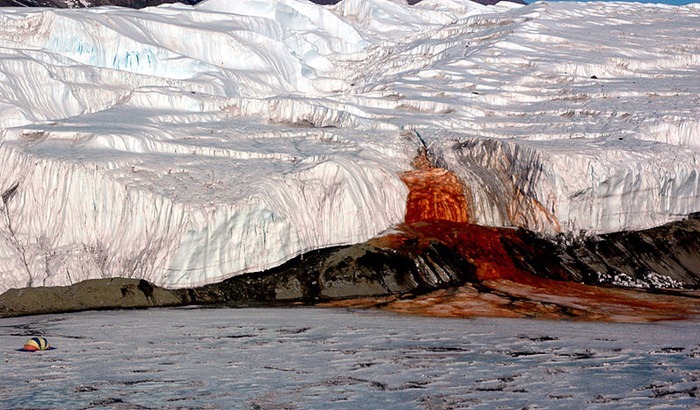
Roughly two million years ago, the Taylor Glacier sealed beneath it a small body of water which contained an ancient community of microbes. Trapped below a thick layer of ice, they have remained there ever since, isolated inside a natural time capsule. With no light or free oxygen and little heat, the microbes had no chance of getting energy through photosynthesis. Instead, the microbes started to live off the minerals that were trapped in the lake with them, evolving independently of the rest of the living world.
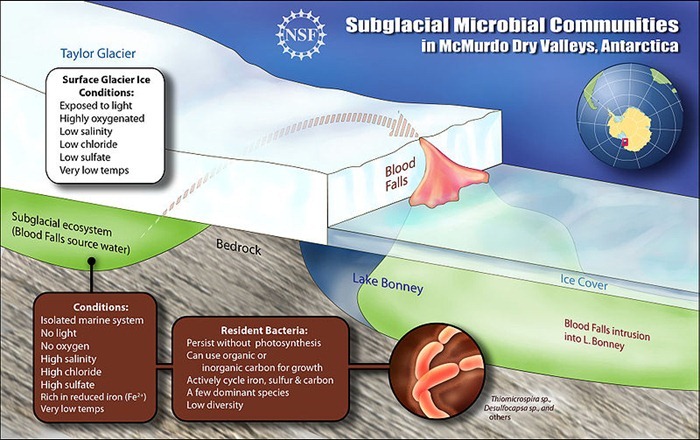
The existence of the Blood Falls ecosystem shows that life can exist in the most extreme conditions on Earth.
The fascinating secrets that remain locked inside the inaccessible sub-glacier lake will help scientist understand the range of conditions to which life can adapt and to advance assessment of the possibility of life elsewhere in the solar system, in places such as Mars or Europa, an ice-covered moon of Jupiter. Indeed, scientists of the NASA Astrobiology Institute speculate that these worlds could contain subglacial liquid water environments favorable to hosting elementary forms of life, which would be better protected at depth from ultraviolet and cosmic radiation than on the surface.
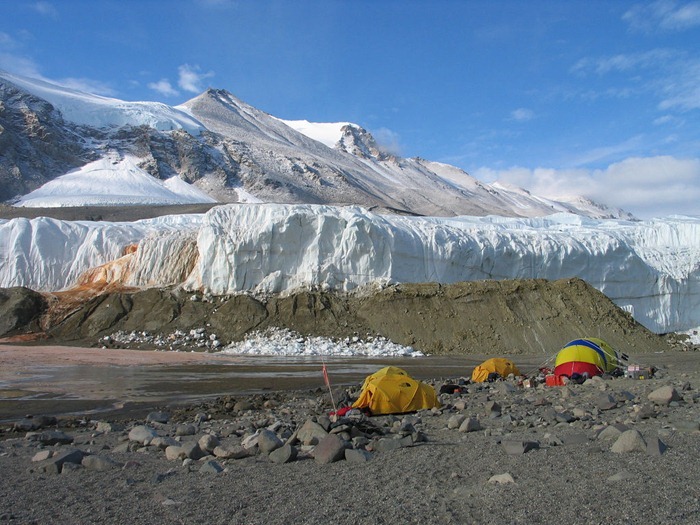
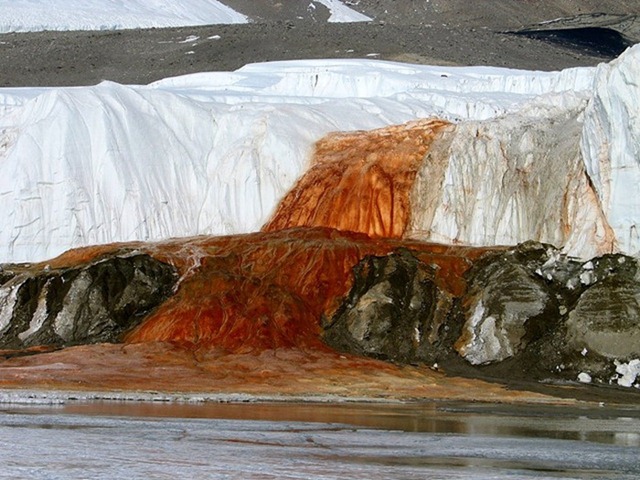
Sources: Wikipedia, Nature News, Science Blogs, Atlas Obscura
sâmbătă, 20 noiembrie 2010
Sfaturi pentru copii de utilizare a Internetului in siguranta
Initiativa Panda Security isi propune sa promoveze utilizarea responsabila si sigura a Internetului in randul tinerilor si este parte a campaniei “Kids on the Web” (http://www.pandasecurity.com/about/social-responsibility/children-internet/).
Cu acest scop, Panda Security ofera acest ghid simplu, practic pentru copii:
- Nu accesati niciodata linkuri suspecte. Cand folositi programe de mesagerie instant (cum ar fi Yahoo Messenger, MSN sau orice alta aplicatie de chat) sau cand veti primi un e-mail, nu accesati niciodata link-ul direct din aceste programe. Daca mesajul sau e-mailul vine direct de la cineva cunoscut, atunci tastati adresa in browser. In cazul in care nu cunoasteti persoana de la care vine mesajul atunci cel mai bine este sa-l ignorati.
- Este periculos sa descarcati sau sa rulati fisiere din surse necunoscute. Fara indoiala ati primit de multe ori mesaje instant invitandu-va sa descarcati o fotografie, o melodie sau un clip video. Uneori, acest fisier ar fi putut fi trimis nu de catre acea persoana, ci de un program malitios care a infectat computerul acestuia si care incearca sa se raspandeasca la alti utilizatori. In acesta situatie cel mai bun lucru pe care il puteti face este sa va intrebati prietenii daca au trimis intr-adevar ceva. Daca nu, informati-i ca sunt infectati astfel incat sa poata sterge fisierul si sa-si informeze celelalte contacte din lista.
- Nu vorbiti cu strainii. In camere chat, pe retelele sociale sau pe messenger, nu puteti fi niciodata complet sigur cu cine stati de vorba atata timp cat nu va puteti vedea. In special in comunitatile online sunt oameni care nu s-au intalnit in viata reala. Niciodata sa nu va imprieteniti cu strainii si in nici un caz nu ar trebui sa va aranjati vreodata intalniri in viaţa reala.
- Nu trimiteti informatii confidentiale prin internet. Nu trimiteti niciodata informatii personale (adresa, numar de telefon etc.) prin email sau instant messaging si nu publicati aceste informatii pe bloguri sau forumuri. De asemenea, trebuie sa fiti atenti cand va creati profile pe retele sociale, cum ar fi Facebook sau Myspace. Nu ar trebui sa divulgati informatii ca varsta sau adresa. Este recomandat sa nu folositi numele vostru adevarat, ci un pseudonim sau porecla.
- Daca aveti cea mai mica banuiala, fiti prudenti. Daca un program pe care nu va amintiti ca l-ati instalat incepe sa afiseze avertizari de infectii sau ferestre care va invita sa cumparati anumite produse, aveti mare grija. Este posibil sa fiti infectat cu unele programe malware.
- Nu navigati singuri pe internet. Daca vreti sa cautati ceva pe internet, este mult mai bine sa cereti ajutorul sau sfatul unui adult, in ceea ce priveste locurile in care sa cautati. Este pe departe mult mai sigur si vizitati site-uri sigure si oficiale, in comparatie cu pagini web necunoscute.
- Vorbiti cu parintii sau tutorii vostri. Daca aveti orice intrebare pe acest subiect, daca observati ceva suspect sau primiti mesaje ofensatoare sau periculoase, luati imediat legatura cu un adult. Ei vor fi in masura sa va sfatuiasca.
“Noile tehnologii devin din ce in ce mai accesibile pentru toate gospodariile. Copiii au acum acces la internet si “decalajul digital’ dintre parinti si copii expune multi tineri pericolelor din internet”, explica Luis Corrons, director tehnic al Panda Security. “Trebuie sa ne asiguram ca tinerii se pot bucura de Web in modul sanatos si sigur. Intotdeauna am recomandat ca cea mai buna forma de a face asta este printr-o relatie parinte – copil bazata pe incredere, ceea ce ar elimina necesitatea monitorizarii constante a copiilor cand navigheaza pe internet sau cand intra pe retelele sociale”.
Despre Panda Security
Incepand cu anul 1990, misiunea PandaLabs a constat in detectarea si eliminarea noilor amenintari cat mai rapid posibil, oferind clientilor nostri un grad maxim de securitate. In acest scop, PandaLabs detine un sistem inovator care analizeaza si clasifica mii de mostre pe zi si ofera verdicte automat (malware sau goodware). Acest sistem sta la baza Collective Intelligence, noul model de securitate al Panda Security, care poate detecta chiar si software-ul malitios nedetectat de alte solutii de securitate.
In prezent, 99,44% din programele malitioase detectate de PandaLabs sunt analizate prin acest sistem. Acesta este completat de activitatea mai multor echipe, fiecare specializata intr-un tip de malware (virusi, viermi, troieni, spyware, phishing, spam, etc.), care lucreaza 24/7 pentru a asigura o acoperire globala.





